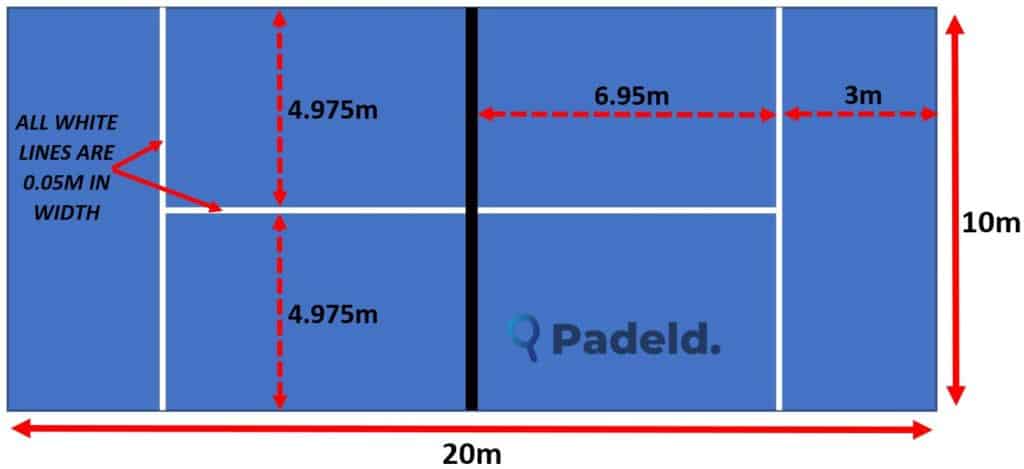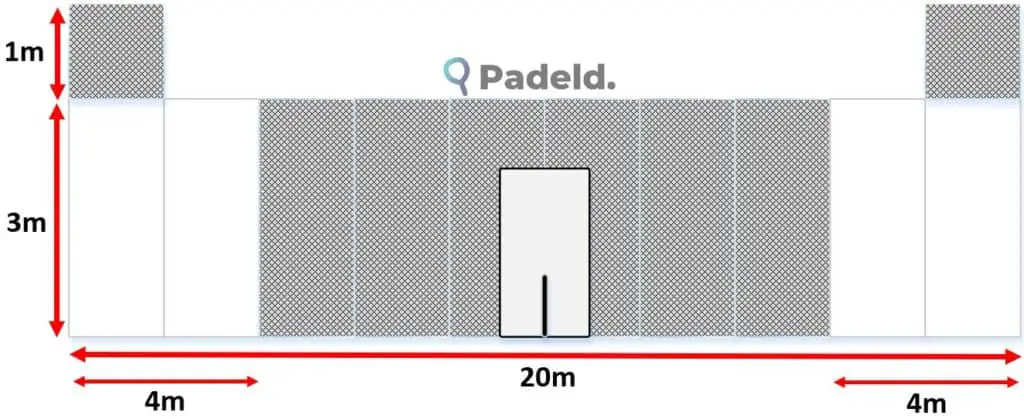With the explosion in popularity of padel across the world in recent years, there are more and more people and businesses looking to build padel courts of their own. Just recently I’ve noticed that a brand new set of courts have been built in my local area, and they have quickly got to the stage where they’re fully booked up with people wanting coaching sessions or wanting to just play a few games against their friends.
If you’re interested in building a padel court, or even if you’re just a casual viewer of the sport and curious as to how it differs in size and material from a tennis court or a squash court – this post has got you covered. I’ll be sharing all the main features and dimensions of a padel court, so if that sounds like the sort of thing you’re looking for then stick around!
So, what are the dimensions of a padel court?
A padel court is an enclosed rectangle that is 10 metres wide by 20 metres long. It is divided in half by a net, making each half of the court symmetrical. The service lines are 6.95 metres away from the net in each direction, and the central service line runs perpendicular to these two lines, splitting them in half.

The exact measurements and distances between the lines on a padel court can be clearly seen in the diagram above. Each of the lines on the court should be 5 centimetres wide and should also be clearly visible to players, umpires and fans. As a result, the lines are usually white in colour, as long as this colour is noticeable when viewed next to the rest of the court surface.
What Are The Dimensions Of The Padel Enclosure?
If you’ve played or watched padel before, you’ll know that the courts are enclosed by a cage-like structure which the ball is allowed to bounce off. So, what are the dimensions of this enclosure and how is it designed? Let’s take a look below!
The Ends Of The Court
The walls at the ends of a padel court are usually 4 metres high. The bottom 3 metres of this wall will usually be made from transparent glass, and the top metre will be made from metallic fencing. These 4-metre-high sections run along the entire back wall, and also slightly down the side wall as is shown in my diagram below!

The Sides Of The Court
The sides of a padel court can vary in their design, but the most common design that you’ll often see on the World Padel Tour looks like the diagram below. You can see that the walls are 4 metres high at the ends as I mentioned in the previous section, and you can also see that the rest of the side panels are 3 metres in height.

If you look at the diagram closely, you will notice that the glass side panels only extend for 4 metres down each side of the court, meaning that the remaining 6 metres on each side are made from metallic fence.
Access Points
Because padel is played inside a cage-like enclosure, players need a way to access the court. Access is usually gained via the use of a specific access point, which is basically a door-shaped hole in the metallic fence on the side of the enclosure. Most padel courts will have one of these access points on each side of the court.
If you’ve watched padel before, you may also be aware that these access points can be used for ‘out of court play’. This means that if the ball travels outside the enclosure, the players can also leave the court and hit the ball back into the enclosure as long as it has not bounced twice already. Because players may need to use the access points to enter and exit the court quickly during points, it is vital that they are appropriately sized to allow this to happen safely. The various options for access point sizing are detailed below:
Option 1: Double Access Point
Certain padel courts have what is known as a ‘double access point’ on both sides of the court. They are positioned exactly in the middle of the side wall of the court, and they feature a partition down the middle of them which the net is usually attached to. This partition creates two entrances, one on either side of the net – hence the name ‘double access point’.
The minimum height of a double access point is 2 metres and the maximum height is 2.2 metres. The minimum width of a single entrance is 0.72 metres, with the maximum width of a single entrance being 1 metre. Because a double access point has two separate entrances (separated by a partition), the minimum and maximum widths that I just stated must be doubled. This means that the minimum width across both entrances is 1.44 metres, and the maximum width across both entrances is 2 metres.
Option 2: Single Access Point
Some padel courts have a single access point on both sides of the court, rather than a double. What is a single access point you ask? Well, it’s basically one that looks like the picture below. It is an access point that doesn’t feature a partition down the middle of it like I just showed you for option 1, creating one singular doorway one each side of the enclosure from which players can enter and exit the court. The single access points will once again be positioned exactly in the middle of the side walls of the court, which means that the net must be positioned in the middle of the access point. Because there is no partition for the net to be attached to, the net will be fastened to a net post that you can also see in the picture below.

The minimum height of a single access point is 2 metres, and the maximum height is 2.2 metres. The minimum width of a single access point is 1.05 metres, with the maximum width of a single access point being 2 metres.
How Large Is The Net On A Padel Court?
The net is located exactly in the centre of the court, running from one side to the other. Because the width of the court is 10 metres, the net must also be 10 metres in length. The net cannot be shorter than this! For example, if the net were only 9 metres in length, this would leave a gap of 0.5 metres between the net post and the metallic fence at either side of the court, making the court unsuitable for competitive play.
The highest point at each end of the net (where it is secured to either the net post or the partition as explained above) must be 0.92 metres in height. The central point of the net must be 0.88 metres in height. The central point of the net is slightly lower than the ends of the net because a material that is stretched over a large distance tends to naturally droop a little in the middle.

How Much Room Is Required Outside A Padel Court?
Out-of-court play in padel is only permitted if the court meets certain standards. If the court doesn’t meet the required standards, then the players will not be permitted to exit the court during a point to hit the ball.
In order to allow out-of-court play there has to be a certain amount of space outside the court in which there are no obstacles. Imagine you’re playing a match, and you leave the court through the access point in order to try and return an opponent’s shot, and you run into a chair or some kit bags that have been left outside enclosure. This could obviously be very dangerous for players and could lead to injuries – therefore it is mandated that these areas must remain clear.
There may not be any obstacles outside the access point within an area that is 2 metres wide, 4 metres long and a minimum of 3 metres wide. The diagram below illustrates what this obstacle-free area looks like in relation to the side of the padel court. This is the same on both sides of the court.

What Is The Minimum Playable Height Throughout The Court?
As I pointed out earlier in this post, the tallest walls on the padel court are at the back of the court on both sides, and they are usually 4 metres high. However, it is possible for the ball to bounce above the height of these walls! Therefore, it doesn’t make sense to allow cameras or spotlights to sit just above the walls of the court. If they were this close, the ball could easily hit them, and this would probably happen regularly!
To avoid occurrences like this, the rules of padel include a ‘minimum playable height’, and there are no obstructions allowed within this limit. For most padel tournaments the minimum playable height is 6 metres, but there has been a push in some circles recently to increase this to 8 metres.
So, if you’re wondering what this means – basically, the padel rules state that throughout the padel court, there can be nothing installed lower than 6 metres to the ground that could possibly obstruct the path of the ball. Any cameras, spotlights, microphones, or screens that are installed above a padel court must be installed more than 6 metres above the ground, as this will lessen the chance that they could interfere with play.
Conclusion
When you start playing a new sport like padel, you want to make sure that the court you’re playing on is fit for purpose and represents the type of court used in a professional setting. If you’re building a court of your own or for other people to use, ensuring it is correctly sized is hugely important! I hope that this post will go some way towards helping you achieve those things.
If you enjoyed this post, I’d encourage you to keep an eye on the site here at Padeld.com. I’m planning to add a raft of posts covering technical and strategic aspects of the sport in the coming months, so lookout for those!
